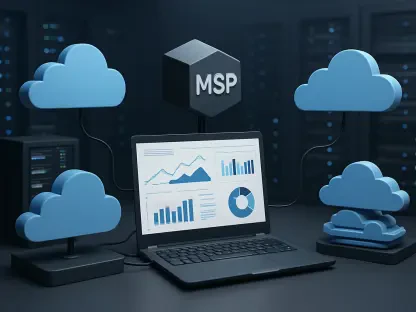The fast-paced digital transformation landscape is reshaping many facets of the public sector, particularly in how workforce management is conducted. With the growing sophistication and frequency of cyber threats, public organizations face mounting pressure to adopt secure, efficient systems that ensure their data privacy and operational integrity. Legacy workforce management systems are increasingly proving inadequate against today’s complex digital threats, thereby driving a pivotal shift towards cloud-based solutions. These solutions not only promise enhanced security and functionality but also bring significant improvements in efficiency and cost-effectiveness. Amid this transformation, secure cloud platforms emerge as a crucial element in the organizational strategies of public entities, offering pathways to modernize operations while maintaining compliance with regulatory requirements. This article delves into the critical role of secure cloud solutions in public workforce management, exploring their potential as a forward-looking strategy for tackling current challenges.
The Imperative of Cybersecurity in Workforce Management
Public sector organizations are under ever-increasing scrutiny to protect sensitive data against an array of cyber threats. The urgency for modernization is underscored by the alarming rise in cyber incidents reported by authorities, reflecting not only an increase in frequency but also in the complexity of such attacks. Traditional workforce management systems, often characterized by outdated infrastructure and limited capabilities, struggle to provide the robust security needed in today’s environment. These systems typically lack the scalability required to adapt swiftly to evolving threats or to manage the growing volume of data handled by public agencies. Consequently, public sector bodies are looking towards cloud solutions as a viable alternative, one that promises greater flexibility, enhanced data protection, and resilience to cyber threats. A well-implemented secure cloud system can offer comprehensive cybersecurity features, including robust encryption, real-time threat monitoring, and continuous software updates, thus strengthening the protective mechanisms that safeguard organizational data assets.
The shift towards cloud solutions is not simply about storing data offsite but involves a transformative approach to managing and securing workforce data. By leveraging advanced features inherent in cloud platforms, public sector organizations can deploy solutions that provide end-to-end data protection, crucial for compliance with government standards. Managed cloud services, tailored for public sector needs, offer built-in security features and regular updates that legacy systems seldom achieve. Frameworks like G-Cloud 14 streamline the procurement of such advanced services, enabling public bodies to adopt them rapidly and with confidence. This structured procurement process is designed to minimize administrative burdens, reduce implementation times, and ensure that the adopted solutions meet both security and operational demands. The ability to effectively manage cybersecurity risks is now integral to public organizations’ strategic planning, and cloud solutions are rapidly becoming a cornerstone of that strategy.
Benefits and Challenges of Cloud Adoption
Rethinking workforce management through secure cloud solutions presents numerous benefits that extend well beyond enhanced cybersecurity. One of the primary advantages is the significant increase in operational efficiency that cloud platforms provide. With features like on-demand scalability and seamless integration with existing systems, public entities can drive innovation and streamline service delivery. This flexibility supports a rapidly changing workforce environment, accommodating shifts in demand and reducing the physical infrastructure required for legacy systems. The operational agility that cloud solutions offer is a key factor driving their adoption, as public organizations seek to align their operations with contemporary digital standards while optimizing resource allocation.
Another critical benefit is cost-effectiveness. Managed cloud services often eliminate the steep capital expenditure associated with traditional IT infrastructure, replacing it with a more manageable operational expenditure model. This shift in payment structure allows public organizations to better control budgeting, scaling services up or down as needed without enduring the extensive financial commitments of owning hardware. Moreover, cloud platforms offer enhanced disaster recovery options, ensuring that data is not only backed up but can be quickly restored, minimizing downtime and service disruption. However, the transition to cloud solutions does not come without its challenges. Concerns related to data sovereignty, varied compliance requirements across different jurisdictions, and the need for ongoing security management can complicate cloud adoption. Public entities must navigate these complexities carefully, ensuring they select solutions that meet both their operational needs and compliance mandates.
The successful implementation of cloud solutions requires careful planning and strategic execution. Public organizations need to assess their current systems, identify specific areas where cloud solutions can deliver the most value, and ensure their workforce is equipped with the skills needed to manage and operate in the new environment. Collaboration with experienced cloud service providers is vital to this transition, as they bring essential insights and expertise to guide public agencies through the technical and organizational aspects of cloud adoption.
Future Directions and Strategic Considerations
The rapidly evolving landscape of digital transformation is significantly influencing various aspects of the public sector, especially in workforce management. With the rise of sophisticated cyber threats and their increasing frequency, public organizations are under considerable pressure to implement secure and efficient systems that protect their data privacy and ensure operational integrity. Traditional workforce management systems are becoming outdated when faced with today’s intricate digital threats, prompting a crucial transition to cloud-based solutions. These modern solutions promise not only enhanced security and functionality but also notable improvements in efficiency and cost reduction. Within this ongoing transformation, secure cloud platforms have become indispensable in the strategic planning of public entities, offering ways to modernize operations while meeting regulatory standards. This discussion examines the essential role of secure cloud solutions in public workforce management, highlighting their potential as forward-thinking strategies to address current challenges effectively.









